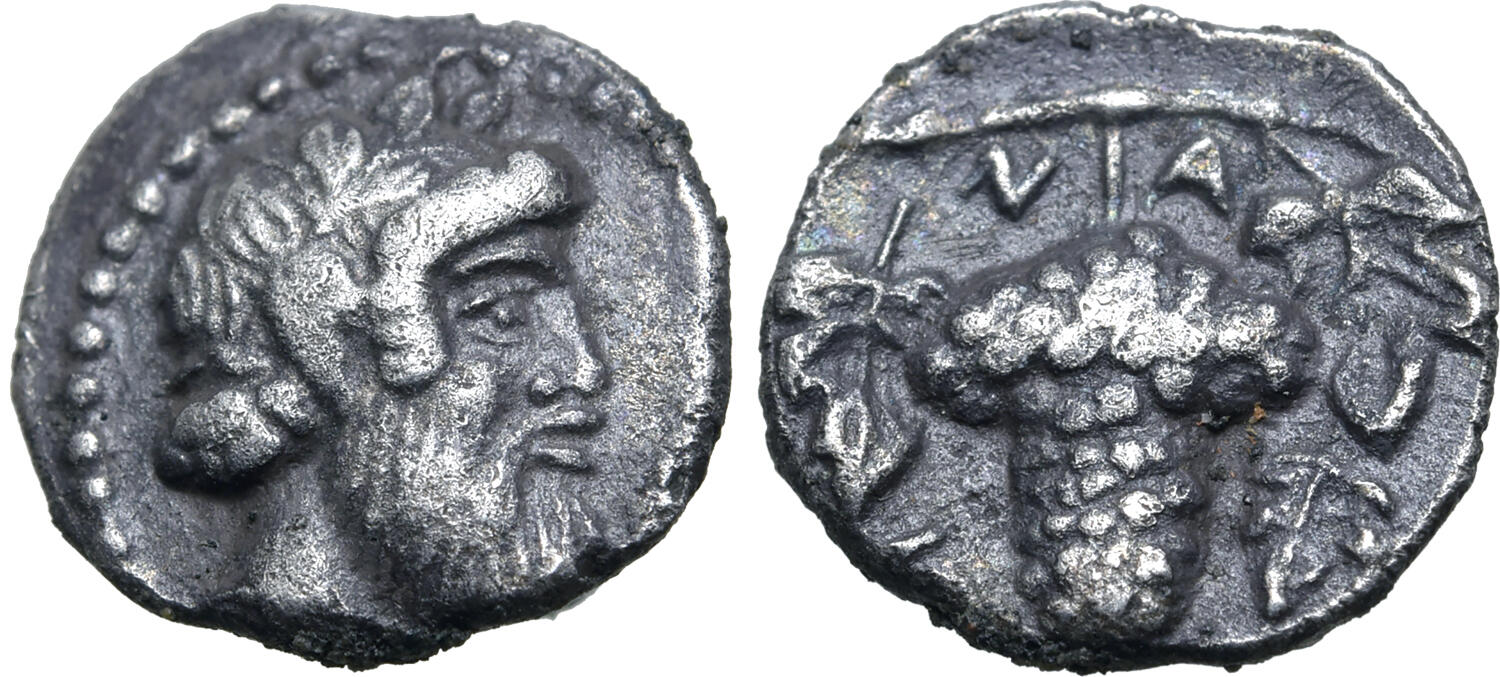AC 79 - Naxus, silver, litrae (461-430 BCE)
From SILVER
461 BCE - 430 BCE Silver 304 kg
Description
| ObverseInscription or printing placed on the obverse.: | Wreathed head of Dionysos to right |
| ReverseInscription or printing placed on the reverse.: | NAXION (Greek).Grape bunch on vine, leaf hanging at each side, leaf to lower right |
Mint and issuing power
| MintIdentifies the place of manufacture or issue of a numismatic object.: | Naxus | Ancient regionAncient region.: | Sicily | Modern countryModern country: Italy | AuthorityIdentifies the issuing power. The authority can be "pretended" when the name or the portrait of X is on the coin but he/she was not the issuing power. It can also be "uncertain" when there is no mention of X on the coin but he/she was the issuing power according to the historical sources: |
Chronology
| FromIdentifies the initial date in a range assigned in a numismatic context. | 461 BCE | toIdentifies the final date in a range assigned in a numismatic context.. | 430 BCE | PeriodTime period of the numismatic object.: Classical 480-323 BC |
Physical description
| MetalThe physical material (usually metal) from which an object is made.: | Silver |
Median weightMedian of the weights of numismatic objects (in grams). in grams | 0.70 | DenominationTerm indicating the value of a numismatic object. Examples: tetradrachm, chalkous, denarius.: | litra |
StandardStandard.: |
Obverse dies distribution
| FrequencyFrequency of specimen in distribution. ᵖ | Number of obversesNumber of obverse dies. ᵖ (o) | % (o) | Number of coinsNumber of coins. (n) | % (n) | Die nameName(s) of the die(s). |
| 1 | 8 | 40 | 8 | 6.96 | 44, 47, 48, 51, 52, 56, 58, 60 |
| 2 | 1 | 5 | 2 | 1.74 | 55 |
| 3 | 3 | 15 | 9 | 7.83 | 46, 50, 59 |
| 4 | 1 | 5 | 4 | 3.48 | 49 |
| 5 | 1 | 5 | 5 | 4.35 | 45 |
| 6 | 1 | 5 | 6 | 5.22 | 57 |
| 8 | 1 | 5 | 8 | 6.96 | 62 |
| 10 | 1 | 5 | 10 | 8.7 | 61 |
| 12 | 1 | 5 | 12 | 10.43 | 63 |
| 16 | 1 | 5 | 16 | 13.91 | 53 |
| 35 | 1 | 5 | 35 | 30.43 | 54 |
| Total | 20 of 20 | 100 | 115 of 115 | 100.01 |
Reverse dies distribution
no distribution is available
Quantification
| Number of obversesNumber of obverse dies. ᵖ (o) | 20 | Number of singletons (o1)The number of singleton coins. ᵖ | 8 |
| Number of reverse diesNumber of reverse dies. (r) | 28 | Number of coinsNumber of coins. (n) | 115 |
| Coins per obverse dieNumber of coins per obverse die. (n/o) | 5.75 | Coins per reverse dieNumber of coins per reverse die. (n/r) | 4.11 |
| Reverse per obverse ratioRatio of obverse dies divided by reverse dies. (r/o) | 1.4 | Percentage of singletons (o1)number of coins (n) divided by the number of singletons (o1) ᵖ | 40 % |
| Original number of dies (O) (Carter 1983 formula)The estimation of the number of coins according to Carter 1983 ᵖ | 21.68 | Coins struck if 20,000 as average productivity per dieCoins made if the average productivity for obverses (according to Carter) is 20,000. ᵖ | 433,600 |
| Original number of dies (O) (Esty 2011 formula)The estimation of the number of coins according to the singleton formula in Esty 2011 ᵖ (O) | 24.21 | Survival rate if 20,000 as average productivity per dieSurvival rate if average productivity is 20,000. ᵖ | 0.00027 |
| Coverage (o = % of O) (Esty 1984 formula)Esty 1984 - coverage (% of O) ᵖ (o = % of O) | 93.04% | Die productivity if survival rate 1/2,000Average productivity if survival rate is 1/2,000. ᵖ | 10,608.86 |
| Weight of silver (in kg) if 20,000 coins per die (O = Carter formula)Carter 1983 * Median weight * 20000 (*10 if gold or electrum) ᵖ | 304 kg <br /> 304 kg | Die productivity if survival rate 1/5,000Average productivity if survival rate is 1/5,000. ᵖ | 26,522.14 |
Remarks
Most likely one single workstation
References
- ^ Cahn, Herbert A. (1944), Die Münzen der sizilischen Stadt Naxos. Ein Beitrag zur Kunstgeschichte des griechischen Westens, Basel, 168 p., XII pl.
- ^ Sear, David R. (1978), Greek coins and their values. Vol. I, Europe, London, xl, 316 p.
- ^ Callataÿ, François de (2003), Recueil quantitatif des émissions monétaires archaïques et classiques, Numismatique Romaine, Wetteren, VII + 267 p.
- ^ Hoover, Oliver D. (2012), The Handbook of Greek Coinage Series. 2. Handbook of the Coins of Sicily (Including Lipara). Civic, Royal, Siculo-Punic, and Romano-Sicilian Issues. Sixth to First Centuries BC, Lancaster-London, 489 p.
